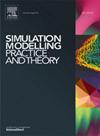Parallelization strategies for high-performance and energy-efficient epidemic spread simulations
IF 3.5
2区 计算机科学
Q2 COMPUTER SCIENCE, INTERDISCIPLINARY APPLICATIONS
引用次数: 0
Abstract
Simulation analysis of epidemic disease spread is crucial for a proper social and governmental response. Certain susceptible–infected–recovered (SIR) models based on cellular automata (CA) have proven to be effective tools for this purpose. Despite the growing interest in these simulation models, few studies have addressed computational efficiency. Many models are not parallelized and, as a result, are computationally inefficient. Moreover, computational efficiency is often solely associated with runtime, with limited attention given to energy consumption and energy-efficient software implementations.
This paper presents various parallel implementations of a successful Covid-19 cellular automaton SIR model on multiprocessors and Graphics Processing Units (GPUs), significantly improving the performance of existing codes while substantially reducing energy consumption. The performance analysis of these parallel implementations demonstrates that simulations can be reduced from hours to under a second, with energy consumption reduced by more than three orders of magnitude. Additionally, the results reveal that in cases where multiple parallel multiprocessor alternatives are available, there is not always a direct correlation between the shortest execution time and the lowest energy consumption in CA simulations.
This work aims to support practitioners interested in implementing or utilizing parallel, energy-efficient SIR model simulations for future epidemic outbreaks, green computing initiatives, and efficient cellular automata simulations in general.
求助全文
约1分钟内获得全文
求助全文
来源期刊

Simulation Modelling Practice and Theory
工程技术-计算机:跨学科应用
CiteScore
9.80
自引率
4.80%
发文量
142
审稿时长
21 days
期刊介绍:
The journal Simulation Modelling Practice and Theory provides a forum for original, high-quality papers dealing with any aspect of systems simulation and modelling.
The journal aims at being a reference and a powerful tool to all those professionally active and/or interested in the methods and applications of simulation. Submitted papers will be peer reviewed and must significantly contribute to modelling and simulation in general or use modelling and simulation in application areas.
Paper submission is solicited on:
• theoretical aspects of modelling and simulation including formal modelling, model-checking, random number generators, sensitivity analysis, variance reduction techniques, experimental design, meta-modelling, methods and algorithms for validation and verification, selection and comparison procedures etc.;
• methodology and application of modelling and simulation in any area, including computer systems, networks, real-time and embedded systems, mobile and intelligent agents, manufacturing and transportation systems, management, engineering, biomedical engineering, economics, ecology and environment, education, transaction handling, etc.;
• simulation languages and environments including those, specific to distributed computing, grid computing, high performance computers or computer networks, etc.;
• distributed and real-time simulation, simulation interoperability;
• tools for high performance computing simulation, including dedicated architectures and parallel computing.
 求助内容:
求助内容: 应助结果提醒方式:
应助结果提醒方式:


